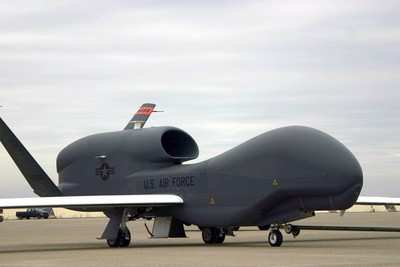Mon, Nov 20, 2006
And Yes, There's A TFR
True or false: the Global Hawk unmanned aerial vehicle has never
flown a mission over US soil. For the moment, the answer is
"true"... but that's likely to change by the end of the day Monday,
when the first Global Hawk is scheduled to land at Beale Air Force
Base outside Sacramento, CA.

"This landmark flight has historic implications since it's the
first time a Global Hawk has not only flown from Beale, but
anywhere in the United States on an official Air Combat Command
mission," said Beale AFB spokesman Capt. Michael Andrews.
But the flight has other implications, as well. To make sure the
remotely-operated Global Hawk doesn't conflict with other traffic
that may be operating in the area... the FAA has established
NOTAM 66504 restricting
operations to all other aircraft in the airspace within a 10-mile
radius of Beale, from 4100' MSL up to and including FL180.
Similar restrictions for UAV operations along the US/Mexico
border met with opposition this year from the
Aircraft Owners and Pilots Association. AOPA maintains
UAVs should be able to detect and avoid other aircraft at least as
well as "see and avoid" works for manned aircraft, before being
allowed to operate over US soil.
 The organization does
not believe TFRs are the answer for UAVs.
The organization does
not believe TFRs are the answer for UAVs.
"It's unacceptable to cordon off large areas of civilian
airspace just because a UAV can't detect and avoid other aircraft,"
said AOPA Executive Vice President for Government Affairs Andy
Cebula, speaking of the 300-mile-long border TFR put in place
earlier this year. "We also believe that before the government
takes large chunks of airspace for the long term, the public should
have that chance to make comments, to make sure government
officials understand the impact of their actions on the people they
work for."
Predator-B drones operated from January through April this year
along a 300-mile stretch of the border. That "temporary" flight
restriction -- originally intended to be in place through the end
of this year, and possibly longer than that -- was rescinded after a Predator-B
crashed April 25.
The Associated Press reports Beale will eventually have seven
Global Hawks by 2009.
More News
From 2023 (YouTube Version): Legacy of a Titan Robert (Bob) Anderson Hoover was a fighter pilot, test pilot, flight instructor, and air show superstar. More so, Bob Hoover was an i>[...]
Get The Latest in Aviation News NOW on Instagram Are you on Instagram yet? It's been around for a few years, quietly picking up traction mostly thanks to everybody's new obsession >[...]
Aero Linx: B-52H Stratofortress The B-52H Stratofortress is a long-range, heavy bomber that can perform a variety of missions. The bomber is capable of flying at high subsonic spee>[...]
Altimeter Setting The barometric pressure reading used to adjust a pressure altimeter for variations in existing atmospheric pressure or to the standard altimeter setting (29.92).>[...]
"Knowing that we play an active part in bettering people's lives is extremely rewarding. My team and I are very thankful for the opportunity to be here and to help in any way we ca>[...]
 Classic Aero-TV: Remembering Bob Hoover
Classic Aero-TV: Remembering Bob Hoover ANN FAQ: Follow Us On Instagram!
ANN FAQ: Follow Us On Instagram! ANN's Daily Aero-Linx (05.15.24)
ANN's Daily Aero-Linx (05.15.24) ANN's Daily Aero-Term (05.15.24):Altimeter Setting
ANN's Daily Aero-Term (05.15.24):Altimeter Setting Aero-News: Quote of the Day (05.16.24)
Aero-News: Quote of the Day (05.16.24)




